Harvesting the cannabis plant at the right time is the first step towards producing high-quality products. How you dry and cure cannabis plays a crucial role in the quality of the final product, as it affects the terpene profile and THC content. Drying cannabis is as much an art as it is science, as it is essential for preserving the quality, potency, and flavour of the carefully cultivated crop.
Whether you’re an experienced grower or a curious enthusiast, understanding the science behind drying and curing cannabis is essential. That’s what we will explore in this detailed guide on how to dry and cure cannabis.
Sections
ToggleWhy Is Drying Cannabis Properly Important?
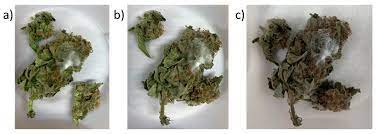
Drying cannabis properly is essential for preserving cannabinoids and terpenes. These are the compounds responsible for the plant’s effects and flavours. Cannabis drying is the process that systematically removes moisture from the buds, serving multiple purposes.
Excess moisture is the breeding ground for mold and mildew, which can spoil the entire harvest. Drying prevents mold growth, ensuring the harvest is not rendered unusable. Proper drying also helps maintain the integrity of cannabinoids like THC and CBD, ensuring the potency of the final product. Additionally, carefully drying cannabis preserves terpenes, the volatile compounds responsible for the unique aromas and flavours of different cannabis strains. Another critical aspect of the correct drying process is that it gradually breaks down chlorophyll, which can contribute to a harsh taste if left in excess.
Ultimately, when cannabis is dried correctly, it undergoes a series of chemical changes that contribute to its final characteristics, making a smooth smoking experience.
Drying Cannabis: The First Step
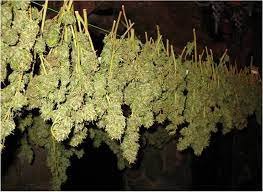
If you are new to the process, here we elaborate on how to dry cannabis.
The process of drying cannabis begins immediately after harvesting. The focus is to carefully remove moisture from the buds while preserving their valuable compounds. Here’s the step-by-step process:
- Harvesting: You should cut down the plants at the base of the stem or remove individual branches. It makes it easier to dry the plant.
- Trimming: Depending on available resources, you can choose between wet trimming (before drying) or dry trimming (after drying). Wet trimming speeds the drying process but may lead to a harsher taste. Dry trimming is more time-consuming but can result in better-preserved trichomes.
- Hanging: Hang all plants or individual branches upside down on drying lines or racks. Keep enough distance between them to ensure proper air circulation.
- Environmental control: You must set up your drying facility with appropriate temperature, humidity, and airflow controls. Let’s take a closer look at ideal cannabis drying conditions:
Ideal drying conditions:
- Temperature: The drying facility must maintain a consistent temperature between 60-70°F (15-21°C). If the temperature is higher, it can cause terpenes to evaporate, while lower temperatures may slow the drying process excessively.
- Humidity: Aim for 45-55% relative humidity to prevent mold growth while avoiding overly rapid drying.
- Airflow: Maintain gentle, consistent air circulation without direct fans blowing on the buds.
- Light: Keep the drying area dark or dimly lit, as light can degrade cannabinoids.
How Do You Know When Cannabis is Dry Enough?
Growers should also be familiar with the process of determining when cannabis is sufficiently dry. Here are some key indicators to look out for:
- Snap test: This test is one of the most reliable indicators of proper drying. Try breaking stems; small stems should snap cleanly when bent rather than fold or bend.
- Stem flexibility: Also, larger stems should bend but not break completely; it indicates the appropriate level of moisture in the plant.
- Texture of buds: Look at the buds; they should feel slightly crisp outside but not crumbly. They should retain some flexibility when gently squeezed.
- Weight: You can also weigh buds, and if they have lost approximately 75-80% of their initial weight, it indicates the appropriate drying level.
- Time: There is no definitive indicator of how long it takes to dry cannabis. Depending on environmental conditions and bud density, it typically ranges from 7 to 14 days.
Remember that how long cannabis takes to dry will vary depending on factors such as humidity, temperature, air circulation, and the size and density of the buds. Patience is key during this phase; rushing the process can lead to subpar results.
How Should Cannabis Smell During Drying?
Drying of cannabis buds directly impacts the aroma. You can use the smell to get valuable insights into the process. During the drying phase, cannabis should maintain a fresh, plant-like smell that gradually transforms into the characteristic scent of the strain. If this aroma evolution is gradual, the drying process is progressing correctly.
Different smells could indicate various issues, and you need to monitor the following carefully:
- Hay-like or grassy smell: If buds start to smell like hay, the drying is too rapid. While it can also be a regular part of the process, it ensures the environment is not too warm.
- Musty or damp odor: Worse, such smell is a potential sign of mold growth or insufficient airflow. If you detect damp odor, carefully inspect cannabis buds for any signs of mold growth.
- Ammonia-like scent: If the harvest decomposes, it will emit an ammonia-like smell. This smell is often due to excessive moisture, requiring you to address the humidity levels immediately.
- Overly strong cannabis smell: This is a desirable smell, but if it has too intensely pungent aroma, it can indicate that terpenes are evaporating too quickly, potentially due to high temperatures.
Drying vs. Curing Cannabis Flower: What's the Difference?
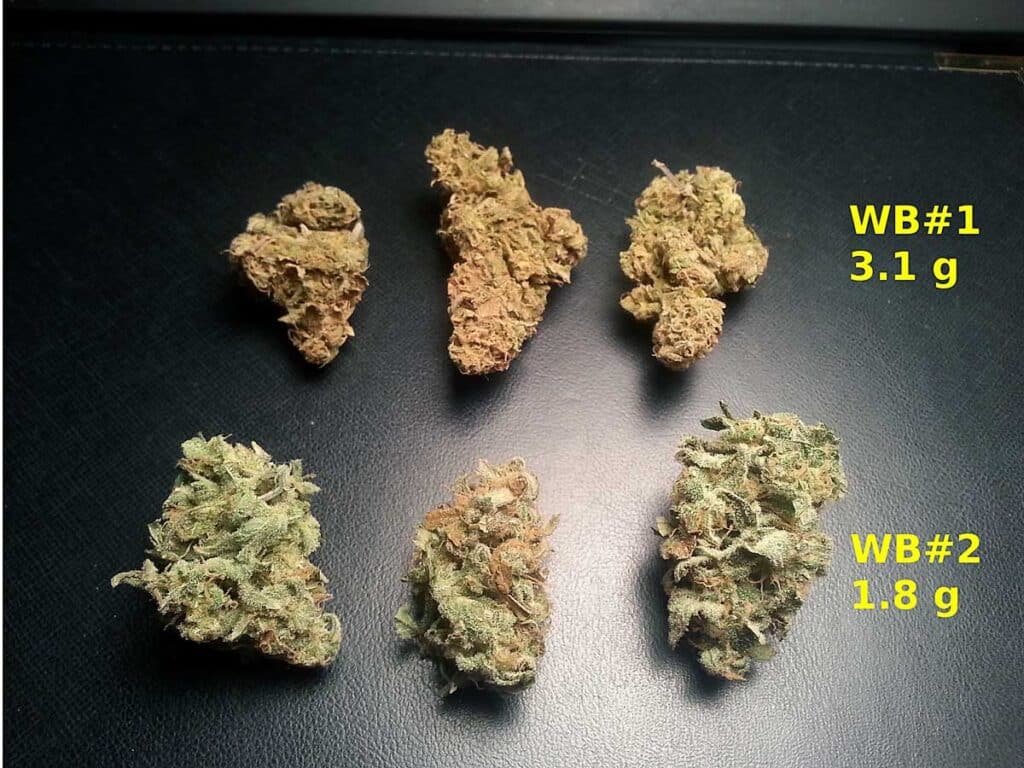
Often, drying and curing of cannabis are collectively considered the same processes, but cannabis drying curing is a process with significant differences. Let’s find out what are these distinctions:
Aspect | Drying | Curing |
Purpose | Remove excess moisture from the plant material | Enhance flavor, aroma, and potency of the dried cannabis |
Duration | 7-14 days | 2-8 weeks or longer |
Temperature & Humidity | 60-70°F, 45-55% relative humidity | 60-70°F, 58-65% relative humidity |
Primary Focus | Reduce the moisture content Initial breakdown of chlorophyll | Facilitate chemical processes and fermentation Continued terpene development, cannabinoid conversion |
Environment | Open air, dark room | Sealed containers, dark storage |
The Curing Process: Unlocking Full Potential
After drying, the next step is curing cannabis, which converts good cannabis into great cannabis. The curing process allows further breakdown of chlorophyll and the development of a more enhanced and diverse terpene profile.
Here, we discuss how to cure cannabis to enhance the flavor, aroma, and overall quality of your buds.
How to Cure Cannabis:
- The first step is to ensure that the cannabis buds are adequately dried before beginning the curing process.
- Choose airtight containers for curing that can prevent air and UV light from entering. Place dried buds into the containers, filling them about 75% complete to allow for air circulation.
- Seal the containers properly and store them in a cool, dark place to protect them from light and heat.
- Open the containers daily for the first week to release built-up moisture and gases. This process is known as “burping” and is crucial for preventing mold.
- Monitor the humidity levels inside the containers. Aim for 58-65% relative humidity and use hygrometers for accurately measuring humidity.
- The ideal duration of curing cannabis is at least 2-4 weeks, but some strains may benefit from months of curing.
Ideal conditions for curing:
- Always use airtight glass jars or stainless steel containers for curing. Avoid plastic containers as they can affect the flavor.
- Cure cannabis at a consistent temperature between 60-70°F (15-21°C) to prevent terpene loss and mold growth.
- Keep relative humidity between 58-65% to allow for continued curing without risking mold development.
- Store curing containers in a dark place to prevent degradation of cannabinoids and terpenes.
Regular monitoring and adjusting of conditions are essential to ensure the best quality of cannabis.
Why Drying and Curing Your Cannabis Is So Important
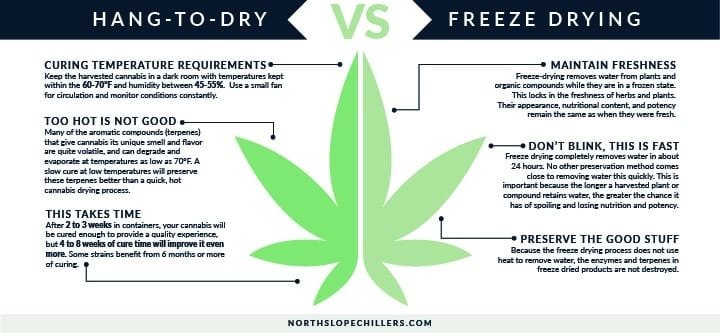
The importance of proper drying and curing of cannabis cannot be overstated. These are fundamental processes that significantly affect the final quality of the product.
- Potency: Curing allows efficient conversion of THCA to THC, potentially increasing potency. During drying, the moisture is reduced, which prevents the degradation of cannabinoids, preserving the plant’s psychoactive and medicinal properties.
- Aroma: Drying and curing develop a terpene profile. Gradual curing enhances the strain’s unique scent profile as it breaks down compounds that can mask the desirable cannabis aroma.
- Flavor: Drying removes harsh chlorophyll from the plant material, revealing more subtle flavor notes. Curing leads to complex flavours as various compounds interact during the process.
- Smoothness: Proper breakdown of chlorophyll and sugars makes for a smoother smoking experience, as well-cured cannabis burns more evenly.
- Longevity: Properly dried and cured cannabis has a longer shelf life, maintaining its quality for extended periods.
Consequences of rushing the process
If you rush the drying or curing process, it can lead to:
- Reduced potency due to degradation of cannabinoids
- Harsh, unpleasant taste from residual chlorophyll
- Risk of mold or mildew growth
- Loss of volatile terpenes, resulting in diminished aroma and effects
- Uneven burning when smoking
- Shorter shelf life and quicker degradation of quality
For growers, it is essential to understand how long it takes to dry cannabis to achieve the best possible results. Patience during drying and curing cannabis pays off in the form of a superior final product.
Common Issues During the Curing Stage
There will be challenges during the curing process, and it’s normal. You need to be aware of these common problems and their solutions:
Issue | Cause | Solution |
Cannabis Overdrying | Low humidity in the plant material, exposure to excessive heat, or prolonged drying time | Rehydrate buds using humidity packs or fresh cannabis leaves; monitor humidity more closely in the future |
Mold Growth | Excessive moisture content, poor air circulation in the facility | Discard affected buds, improve ventilation in the facility, and monitor humidity closely |
Loss of Terpene Aroma | High temperatures, exposure to light, or oxidation | Store in dried cannabis in airtight containers in a cool, dark place Consider vacuum sealing for long-term storage Minimize container opening |
Tools and Equipment for Drying and Curing
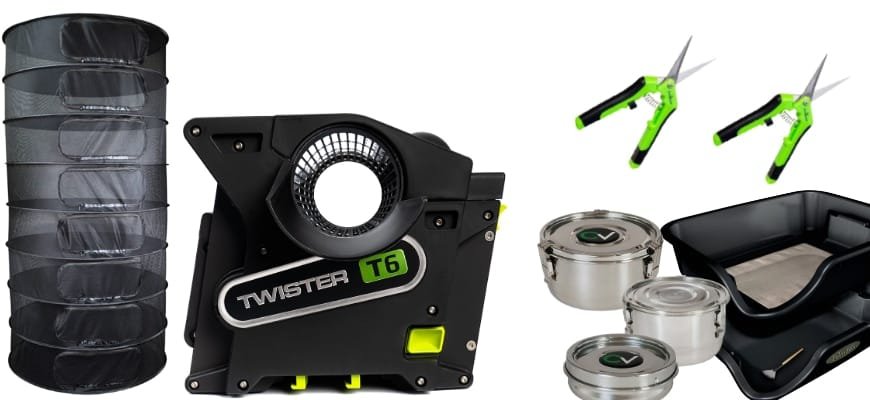
For effective drying and curing of cannabis, you will need the appropriate tools. Here is a list of equipment that every cannabis processing facility must have:
- Spacious drying racks or lines for hanging branches
- Temperature and humidity control equipment such as air conditioners and dehumidifiers
- Airtight containers such as mason jars and CVaults
- Hygrometers for monitoring humidity levels
- Trimming scissors for manicuring buds
- Appropriate size exhaust fans for proper air circulation depending on the size of the facility
- Cool, dark storage area
- Humidity packs for maintaining optimal moisture levels
- Gloves for handling buds without contamination
- Labels and markers for tracking strains and curing progress
Maintaining Cleanliness in Post-Harvest Production
Maintaining cleanliness throughout the process is essential to avoid contamination and product quality degradation. Here are some tips to prevent contamination during the cannabis drying and curing process:
- Regularly clean and disinfect all surfaces and equipment using food-grade sanitizers.
- Staff must use food-grade gloves when handling cannabis to prevent contamination from skin oils.
- Ensure proper ventilation in facility and storage units.
- Monitor for pests and implement preventative measures such as sticky traps or natural deterrents.
- Use HEPA air purifiers to reduce airborne contaminants in drying and curing areas.
- Make it mandatory for staff to change clothes before entering drying and curing spaces to reduce the introduction of outside contaminants.
- Use sterile containers for curing to prevent the introduction of bacteria or mold spores.
How to Add Moisture Back in if It's Overdry
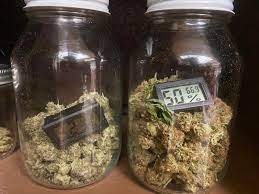
At times, you might face situations where cannabis buds are overdried. It doesn’t mean you have to settle for low-quality output; you can rehydrate them without significantly affecting quality. There are several ways to rehydrate overdried cannabis.
- Humidity packs: You can use humidity packs such as Boveda and Integra Boost, explicitly designed for cannabis. These packs can add and remove moisture to maintain an ideal humidity level.
- Use plant material: Alternatively, temporarily place a small piece of fresh cannabis leaf in the container. This can slowly reintroduce moisture to the dried buds.
- Store in a slightly higher humidity environment: For a short time, place over dry cannabis in such an environment to moisturize buds again.
Whatever method you choose, always monitor closely when rehydrating cannabis to prevent over-moisturizing and potential mold growth.
Conclusion
Perfecting the science of drying and curing cannabis is essential for producing high-quality, flavorful, and potent products. When you know how to dry cannabis correctly, you can ensure high-quality yield consistently. While each strain may require slight adjustments to the process, the processes shared in this guide provide a general guideline for producing cannabis that stands out for its quality, flavor, and effects.




